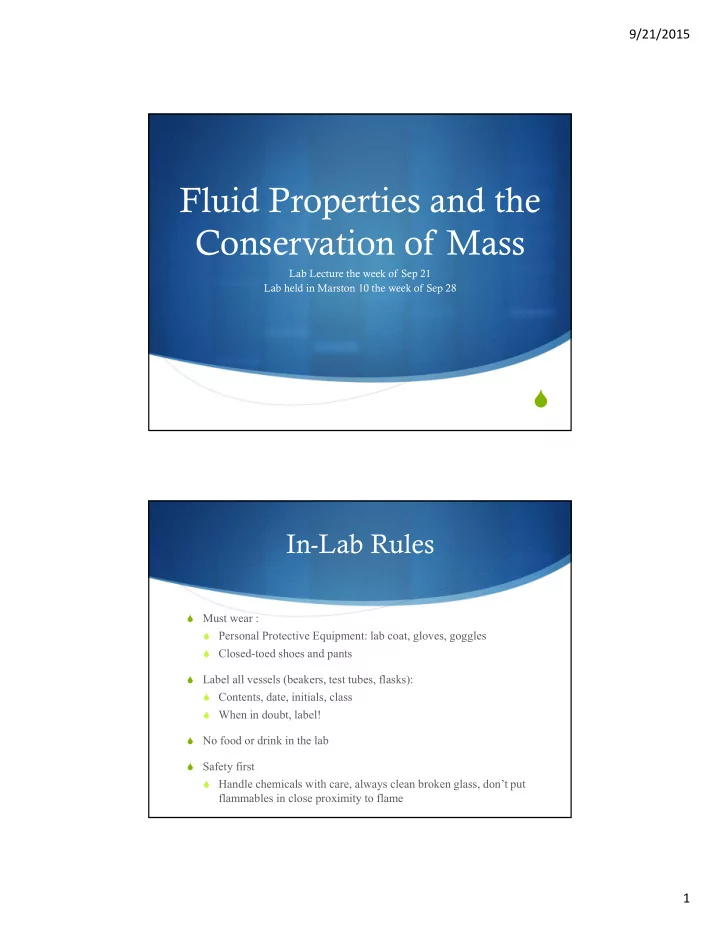

9/21/2015 Fluid Properties and the Conservation of Mass Lab Lecture the week of Sep 21 Lab held in Marston 10 the week of Sep 28 In-Lab Rules Must wear : Personal Protective Equipment: lab coat, gloves, goggles Closed-toed shoes and pants Label all vessels (beakers, test tubes, flasks): Contents, date, initials, class When in doubt, label! No food or drink in the lab Safety first Handle chemicals with care, always clean broken glass, don’t put flammables in close proximity to flame 1
9/21/2015 Fluid Properties 1. Density of a substance: the quantity of matter contained in a unit volume of the substance Mass density ρ (kg/m 3 )=m/V Specific weight ω (N/m 3 )= ρ g Relative density σ = ρ s / ρ H20 2. Viscosity: property of fluid, due to cohesion and interaction between molecules, which offers resistance to deformation. Dynamic viscosity μ Kinematic viscosity ν Reynold’s Number Ratio of the inertial forces ( ρ v 2 /L ) to viscous forces ( μ v /L 2 ) . Re= ρ vL/ μ =vL/ υ =vD/ υ ν = μ / ρ μ is the dynamic viscosity of the fluid (kg/(m.s)), v is the maximum velocity of an object relative to a fluid (m/s) or mean fluid velocity, L is the traveled length of the fluid (m) (the symbol D is used sometimes instead of L as the hydraulic diameter), and υ is kinematic viscosity (m 2 /s). 2
9/21/2015 Conservation of Mass Antoine Lavoisier’s Law (1789): m in m out mass is neither created nor Control destroyed: m in =m out volume Q in Q out Objectives Measure the density of water Check fluid velocity using Reynold’s number criterion Estimate terms in conservation of water mass equation 3
9/21/2015 Part 1 – Calculating density Weigh 250-mL volume of water Measure the water temperature Calculate density Part 2 – Calculating the cross- sectional area of the tube Measure the length of a given flexible tubing Fill the tube with water Measure the volume of water in the tube Record the water temperature Use V = π D 2 /4 (where D is the internal diameter of the tube) to calculate D Find the cross-sectional area of the tube 4
9/21/2015 Part 3 – Calculating the velocity of a slow jet Measure the time required by a slow jet of water from the faucet to fill a 250-mL graduated cylinder Repeat 3 times Calculate the flow rate of the slow jet Q=V/t Calculate the velocity of the slow jet: v=Q/A Calculate = vD/ ν Part 4 – Calculating the velocity of a fast jet Measure the time required by a slow jet of water from the faucet to fill a 250-mL graduated cylinder Repeat 3 times Calculate the flow rate of the slow jet Q=V/t Calculate the velocity of the slow jet: v=Q/A Calculate = vD/ ν 5
9/21/2015 Part 5:Conservation of mass equation Calculate the horizontal cross-sectional area of the sink Measure the time required for the free surface in the sink to rise 17 cm. Use a stopwatch and scale. Calculate Q in Observe the time required to drop each centimeter until the sink fully drains. Use a measuring stick and a stop watch. Calculate Q out Control volume of sink 6
Recommend
More recommend